NCERT Solutions for Exercise 11.1 Class 10 Maths Chapter 11 - Constructions
CBSE Class 10th Exam Date:01 Jan' 26 - 14 Feb' 26
NCERT Solutions For Class 10 Maths Chapter 11 Exercise 11.1
NCERT Solutions for Exercise 11.1 Class 10 Maths Chapter 11 Constructions are discussed here. These NCERT solutions are created by subject matter expert at Careers360 considering the latest syllabus and pattern of CBSE 2023-24. Class 10 Maths ex 11.1 enlists a few practice problems on the construction of triangles with given measurements base and heights. In the later section some more questions, terms related to the property of triangles, and how its construction can be made in two-dimensional geometry will be discussed.
10th class Maths exercise 11.1 answers are designed as per the students demand covering comprehensive, step by step solutions of every problem. Practice these questions and answers to command the concepts, boost confidence and in depth understanding of concepts. Students can find all exercise together using the link provided below.
Download Free Pdf of NCERT Solutions for Class 10 Maths chapter 11 exercise 11.1
Assess NCERT Solutions for Class 10 Maths chapter 11 exercise 11.1
Constructions Class 10 Chapter 11 Exercise: 11.1
In each of the following, give the justification of the construction also:
Q1 Draw a line segment of length 7.6 cm and divide it in the ratio 5 : 8. Measure the two parts.
Answer:
Steps of construction:-
(i) Draw a line segment AB of measurement 7.6 cm (length).
(ii) Now draw an acute angle AC with line segment AB.
(iii) Now cut 13 equal points on the line AC where the zeroth point is A.
(iv) Join the 13th point with point B. So the new line is BA 13 .
(v) Now, from point A 5 draw a line parallel to BA 13 on line AB. Name the point as D.
The point D is the required point which divides the line segment in the ratio of 5: 8.
The length of the two parts obtained is 2.9 cm and 4.7 cm for AD and DB respectively.

Justification:- In the figure, we can see two similar triangles: $\Delta ADA_5$ and $\Delta ABA_{13}$
Thus $\frac{AA_5}{A_5A_{13}}\ =\ \frac{AD}{DB}\ =\ \frac{5}{8}$ .
Answer:
Steps of construction are:-
(i) Firstly draw a line segment AB of length 4 cm.
(ii) Now cut an arc of radius 5 cm from point A and an arc of 6 cm from point B.
(iii) Name the point of intersection of arcs to be point C.
(iv) Now join point AC and BC. Thus $\Delta$ ABC is the required triangle.
(v) Draw a line AD which makes an acute angle with AB and is opposite of vertex C.
(vi) Cut three equal parts of line AD namely AA 1 , AA 2 , AA 3 .
(vii) Now join A 3 to B. Draw a line A 2 B' parallel to A 3 B.
(viii) And then draw a line B'C' parallel to BC.
Hence $\Delta$ AB'C' is the required triangle.
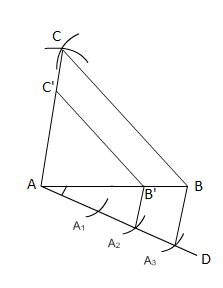
Answer:
Steps of construction are:-
(i) Firstly draw a line segment AB of length 5 cm.
(ii) Now cut an arc of radius 6 cm from point A and an arc of 7 cm from point B.
(iii) Name the point of intersection of arcs to be point C.
(iv) Now join point AC and BC. Thus $\Delta$ ABC is the required triangle.
(v) Draw a line AD which makes an acute angle with AB and is opposite of vertex C.
(vi) Cut seven equal parts of line AD namely AA 1 , AA 2 , AA 3 , AA 4 , AA 5 , AA 6 , AA 7 ,.
(vii) Now join A 5 to B. Draw a line A 7 B' parallel to A 5 B.
(viii) And then draw a line B'C' parallel to BC.
Hence $\Delta$ AB'C' is the required triangle.
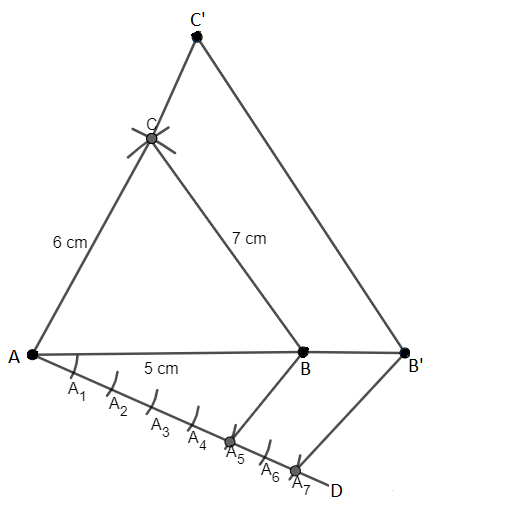
Answer:
Steps of construction:-
(i) Draw a line segment AB of length 8 cm.
(ii) Cut arcs taking point A and point B as the center. Draw the line to intersect on line segment AB. Mark the intersecting point as point D.
(iii) Cut arc of length 4 cm on the same line which will be the altitude of the triangle.
(iv) Name the point as C. Then $\Delta$ ABC is the isosceles triangle.
(v) Draw a line AX which makes an acute angle with AB and is opposite of vertex C.
(vi) Cut seven equal parts of line AX namely AA 1 , AA 2 , AA 3 .
(vii) Now join A 2 to B. Draw a line A 3 B' parallel to A 2 B.
(viii) And then draw a line B'C' parallel to BC.
Hence $\Delta$ AB'C' is the required triangle.

Answer:
Steps of construction:-
(i) Draw a line segment BC with a measurement of 6 cm.
(ii) Now construct angle 60 o from point B and draw AB = 5 cm.
(iii) Join point C with point A. Thus $\Delta$ ABC is the required triangle.
(iv) Draw a line BX which makes an acute angle with BC and is opposite of vertex A.
(v) Cut four equal parts of line BX namely BB 1 , BB 2 , BB 3 , BB 4.
(vi) Now join B 4 to C. Draw a line B 3 C' parallel to B 4 C.
(vii) And then draw a line B'C' parallel to BC.
Hence $\Delta$ AB'C' is the required triangle.
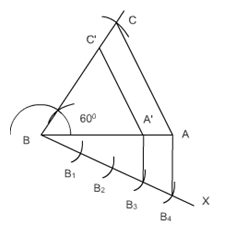
Answer:
Steps of construction:-
(i) Draw a line segment BC.
(ii) Now draw an angle $\angle$ B = 45 o and $\angle$ C = 30 o and draw rays in these directions.
(iii) Name the intersection of these lines as A.
(iv) Thus $\bigtriangleup ABC$ is the required triangle.
(v) Draw a line BX which makes an acute angle with BC and is opposite of vertex A.
(vi) Cut four equal parts of line BX namely BB 1 , BB 2 , BB 3 , BB 4.
(vii) Now join B 3 to C. Draw a line B 4 C' parallel to B 3 C.
(viii) And then draw a line B'C' parallel to BC.
Hence $\Delta$ AB'C' is the required triangle.
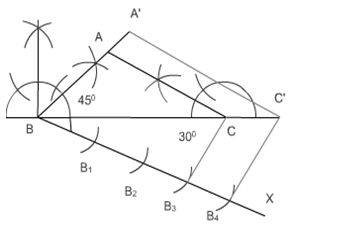
Answer:
Steps of construction:-
(i) Draw a line segment AB having a length of 4 cm.
(ii) Now, construct a right angle at point A and make a line of 3 cm.
(iii) Name this point C. Thus $\Delta$ ABC is the required triangle.
(iv) Draw a line AX which makes an acute angle with AB and is opposite of vertex C.
(v) Cut four equal parts of line AX namely AA 1 , AA 2 , AA 3 , AA 4 , AA 5 .
(vi) Now join A 3 to B. Draw a line A 5 B' parallel to A 3 B.
(vii) And then draw a line B'C' parallel to BC.
Hence $\Delta$ AB'C' is the required triangle.
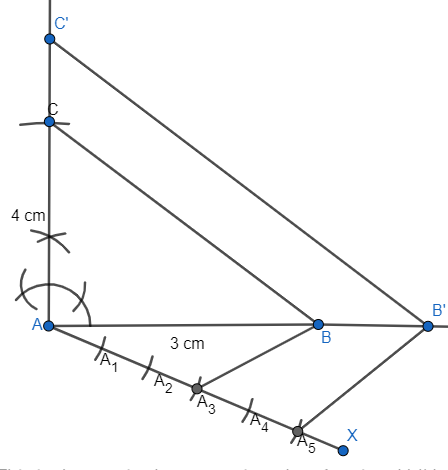
More About NCERT Solutions for Class 10 Maths Chapter 11 Exercise 11.1
This section contains the extra information the source and scenario of content present in exercise 11.1 Class 10 Maths. Starting from the first. This exercise 11.1 Class 10 is there to represent the problems based on building triangles over conditions provided and given measurements i.e. AB and AC in triangle ABC. As the number increases in ascending for the questions, concepts get changed like here will be discussing other questions based on the property of the triangle mentioned in the previous chapter. So in simple words, we say Class 10 Maths chapter 11 exercise 11.1 is basically a Platform in the roadmap to learn more about 2D Geometry for beginners.
Also Read| Constructions Class 10 Notes
Benefits of NCERT Solutions for Class 10 Maths Chapter 11 Exercise 11.1
NCERT solutions for Class 10 Maths chapter 11 exercise 11.1 are important as to get better understanding over the subject.
Another benefit of exercise 11.1 Class 10 Maths is makes students understand terminologies like construction procedures and justification of the given diagram.
Student can solve most of the question provided to him/her in his HW, exams or test.
Also see-
NCERT Solutions Subject Wise
Frequently Asked Questions (FAQs)
The radius of the given circle is 10cm and point A is 8 cm from center of circle hence
The point lies inside of the circle hence no tangents can be traced from that point
A perpendicular line segment traced from the vertex of a triangle to the opposite side is called an Altitude
There are a total of 2 exercises in chapters 11 ie exercise 11.1 and 11.2
Toughness of any chapter exercise and topic is based on the amount of hard work required to master that thing. As far as this chapter is concerned students need to follow definite path in order to solve each and every question of maths
The sum of all angles of triangle is 180 degrees
Questions related to CBSE Class 10th
On Question asked by student community
Good Morning, candidate,
The question papers will be available soon at the link attached herewith. You can keep an eye on the website of careers360. it will provide you perfect pattern of question papers, which will improve your writing skills and practice learning.
https://school.careers360.com/articles/cbse-sahodaya-class-10-pre-board- question-paper-2025-26
Thank you.
Hello,
You can download subject wise CBSE Sahodaya Class 10 Pre-Board Question Paper 2025-26 for Round 1 & Round 2 from this link : CBSE Sahodaya Class 10 Pre-Board Question Paper 2025-26
Hope it helps !
Hello there,
Solving question papers is one of the best method of preparation. It gives you proper idea about the exam pattern and important topics to cover.
Here is the link attached from the official website of Careers360 which will provide you with the CBSE Sahodaya question papers. Hope it helps!
https://school.careers360.com/articles/sahodaya-question-paper-2025
thank you!
The CBSE Class 10 Hindi Question Paper Blueprint (Marking Pattern) for the 2025-2026 Board Exam is divided into four main sections, with a total of 80 marks for the written exam. The structure is slightly different for Hindi Course A and Hindi Course B.You can download the official Sample Question Paper (SQP) and its Marking Scheme for both Hindi Course A and Course B here: https://school.careers360.com/boards/cbse/cbse-class-10-hindi-sample-papers-2025-26
The CBSE Sahodaya Question Papers for Class 10 (2025-26) are not released centrally by the board as a single PDF.
Here is the essential information you need:
-
Local Release: The papers are designed and released by the individual Sahodaya School Clusters (groups of CBSE schools) just before or during the pre-board exam dates (typically held in December and January). Therefore, you must check your local cluster's portal or directly with your school administration.
-
Best Practice: The official model papers, based on the full 2026 syllabus, are the most reliable tool for practice. These accurately reflect the structure, format, and competency-based questions used in the Sahodaya exams.
You can download the latest CBSE Class 10 Model Papers to simulate the Sahodaya tests here: https://school.careers360.com/articles/sahodaya-question-paper-2025 . Focus on that pattern
Applications for Admissions are open.
As per latest syllabus. Physics formulas, equations, & laws of class 11 & 12th chapters
JEE Main Important Chemistry formulas
Get nowAs per latest syllabus. Chemistry formulas, equations, & laws of class 11 & 12th chapters
JEE Main high scoring chapters and topics
Get nowAs per latest 2024 syllabus. Study 40% syllabus and score upto 100% marks in JEE
JEE Main Important Mathematics Formulas
Get nowAs per latest syllabus. Maths formulas, equations, & theorems of class 11 & 12th chapters
